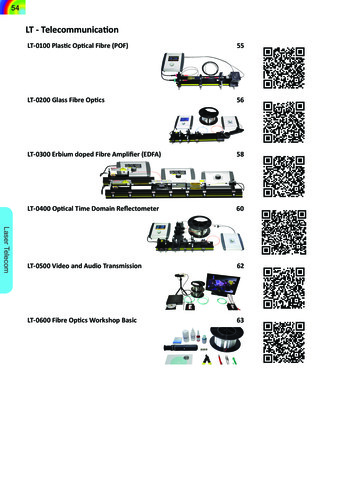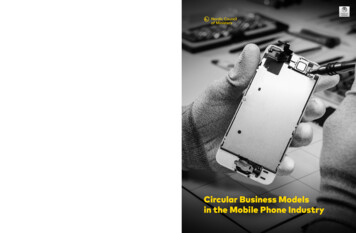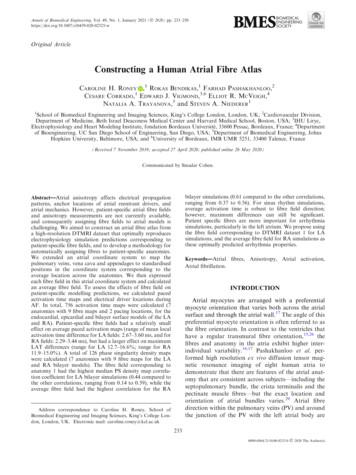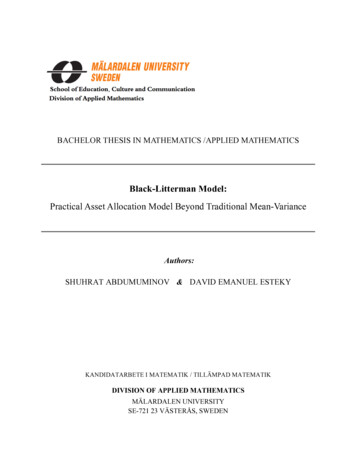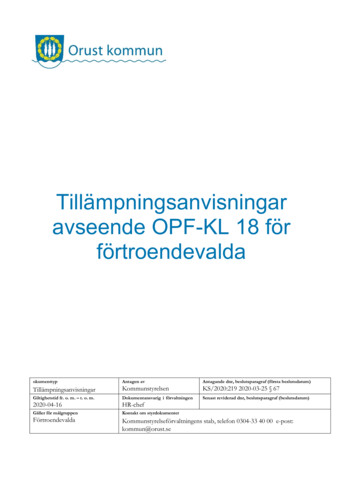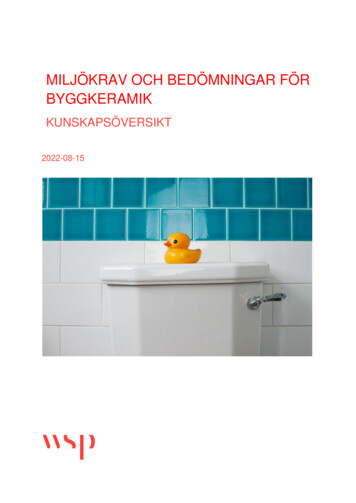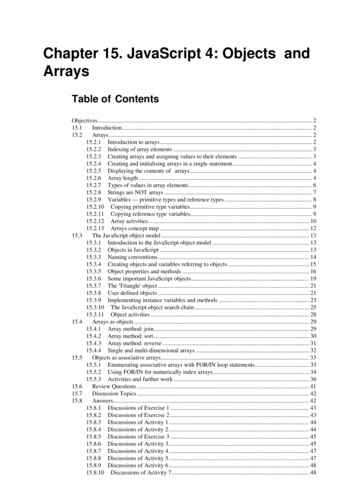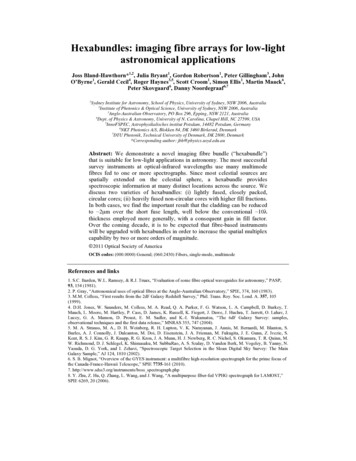
Transcription
Hexabundles: imaging fibre arrays for low-lightastronomical applicationsJoss Bland-Hawthorn*1,2, Julia Bryant1, Gordon Robertson1, Peter Gillingham3, JohnO’Byrne1, Gerald Cecil4, Roger Haynes3,5, Scott Croom1, Simon Ellis1, Martin Maack6,Peter Skovgaard6, Danny Noordegraaf6,71Sydney Institute for Astronomy, School of Physics, University of Sydney, NSW 2006, Australia2Institute of Photonics & Optical Science, University of Sydney, NSW 2006, Australia3Anglo-Australian Observatory, PO Box 296, Epping, NSW 2121, Australia4Dept. of Physics & Astronomy, University of N. Carolina, Chapel Hill, NC 27599, USA5InnoFSPEC, Astrophysikalisches institut Potsdam, 14482 Potsdam, Germany6NKT Photonics A/S, Blokken 84, DK 3460 Birkerød, Denmark7DTU Photonik, Technical University of Denmark, DK 2800, Denmark*Corresponding author: jbh@physics.usyd.edu.auAbstract: We demonstrate a novel imaging fibre bundle (“hexabundle”)that is suitable for low-light applications in astronomy. The most successfulsurvey instruments at optical-infrared wavelengths use many multimodefibres fed to one or more spectrographs. Since most celestial sources arespatially extended on the celestial sphere, a hexabundle providesspectroscopic information at many distinct locations across the source. Wediscuss two varieties of hexabundles: (i) lightly fused, closely packed,circular cores; (ii) heavily fused non-circular cores with higher fill fractions.In both cases, we find the important result that the cladding can be reducedto 2µm over the short fuse length, well below the conventional 10λthickness employed more generally, with a consequent gain in fill factor.Over the coming decade, it is to be expected that fibre-based instrumentswill be upgraded with hexabundles in order to increase the spatial multiplexcapability by two or more orders of magnitude. 2011 Optical Society of AmericaOCIS codes: (000.0000) General; (060.2430) Fibers, single-mode, multimodeReferences and links1. S.C. Barden, W.L. Ramsey, & R.J. Truax, “Evaluation of some fibre optical waveguides for astronomy,” PASP,93, 154 (1981).2. P. Gray, “Astronomical uses of optical fibres at the Anglo-Australian Observatory,” SPIE, 374, 160 (1983).3. M.M. Colless, “First results from the 2dF Galaxy Redshift Survey,” Phil. Trans. Roy. Soc. Lond. A. 357, 105(1999).4. D.H. Jones, W. Saunders, M. Colless, M. A. Read, Q. A. Parker, F. G. Watson, L. A. Campbell, D. Burkey, T.Mauch, L. Moore, M. Hartley, P. Cass, D. James, K. Russell, K. Fiegert, J. Dawe, J. Huchra, T. Jarrett, O. Lahav, J.Lucey, G. A. Mamon, D. Proust, E. M. Sadler, and K.-I. Wakamatsu, “The 6dF Galaxy Survey: samples,observational techniques and the first data release,” MNRAS 355, 747 (2004).5. M. A. Strauss, M. A., D. H. Weinberg, R. H. Lupton, V. K. Narayanan, J. Annis, M. Bernardi, M. Blanton, S.Burles, A. J. Connolly, J. Dalcanton, M. Doi, D. Eisenstein, J. A. Frieman, M. Fukugita, J. E. Gunn, Z. Ivezic, S.Kent, R. S. J. Kim, G. R. Knapp, R. G. Kron, J. A. Munn, H. J. Newberg, R. C. Nichol, S. Okamura, T. R. Quinn, M.W. Richmond, D. J. Schlegel, K. Shimasaku, M. SubbaRao, A. S. Szalay, D. Vanden Berk, M. Vogeley, B. Yanny, N.Yasuda, D. G. York, and I. Zehavi, “Spectroscopic Target Selection in the Sloan Digital Sky Survey: The MainGalaxy Sample,” AJ 124, 1810 (2002).6. S. B. Mignot, “Overview of the GYES instrument: a multifibre high-resolution spectrograph for the prime focus ofthe Canada-France-Hawaii Telescope,” SPIE 7735-161 (2010).7. http://www.sdss3.org/instruments/boss spectrograph.php8. Y. Zhu, Z. Hu, Q. Zhang, L. Wang, and J. Wang, “A multipurpose fiber-fed VPHG spectrograph for LAMOST,”SPIE 6269, 20 (2006).
9. S.C. Ellis, Driver, S. P., Allen, P.D., Liske, J., Bland-Hawthorn, J., De Propris, R., “The Millenium GalaxyCatalogue: On the Natural Subdivision of Galaxies,” MNRAS 363, 1257 (2005).10. G. J. Hill, P. J. MacQueen, M. P. Smith, J. R. Tufts, M. M. Roth, A. Kelz, J. J. Adams, N. Drory, F. Grupp, S. I.Barnes, G. A. Blanc, J. D. Murphy, W. Altmann, G. L. Wesley, P. R. Segura, J. M. Good, J. A. Booth, S.-M. Bauer,E. Popow, J. A. Goertz, R. D. Edmonston, and C. P. Wilkinson, “The Design, Construction and Performance ofVIRUS-P: the Prototype for a Highly Replicated Integral Field Spectrograph for HET,” SPIE, 7014, 231 (2008).11. S.C. Barden & R.A. Wade, “DensePak and Spectral Imaging with Fibre Optics,” In Fibre Optics in Astronomy,113 (1988).12. I. J. Lewis, M. Balogh, R. De Propris, W. Couch, R. Bower, A. Offer, J. Bland-Hawthorn, I. K. Baldry, C. Baugh,T. Bridges, R. Cannon, S. Cole, M. Colless, C. Collins, N. Cross, G. Dalton, S. P. Driver, G. Efstathiou, R. S. Ellis, C.S. Frenk, K. Glazebrook, E. Hawkins, C. Jackson, O. Lahav, S. Lumsden, S. Maddox, D. Madgwick, P. Norberg, J.A. Peacock, W. Percival, B. A. Peterson, W. Sutherland, and K. Taylor, “The Anglo-Australian Observatory 2dFfacility,” MNRAS 333, 279 (2002).13. G.J. Hill, Department of Astronomy, University of Texas, Austin, TX, USA (2010).14. R. Bacon, Observatoire de Lyon, CRAL – Université de Lyon, Lyon, France (2010).15. A.W. Snyder & J.D. Love, Optical Waveguide Theory, Chapman & Hall, 2nd ed. (2000).16. J.J. Bryant, J. O’Byrne, J. Bland-Hawthorn & S. Leon-Saval, “Characterisation of hexabundles: initial results,”MNRAS, submitted (2010).17. A.M. Moore, R. Dekany, D. Jones, R. Smith, K. Taylor, and V. Velur, “Spine development for the Echidna fibrepositioner,” SPIE 4841, 1429 (2003).18. A.M. Moore, P. R. Gillingham, J. S. Griesbach, and M. Akiyama, “POSM: a new concept for fibre positioning,”SPIE 6269, 54 (2006).19. G. Wang, “Fibre positioning of LAMOST,” SPIE, 4008, 922 (2000).1. IntroductionHistorically, telescopes were used to observe one source at a time on the celestial sphere. Butwith advances in optical fibres, it was realized in the early 1980s that many sources could beobserved across the telescope focal plane simultaneously by positioning optical fibres acrossthe field [1,2]. This led to an explosion in wide-field astronomical surveys: the Two DegreeField Galaxy Redshift Survey [3], the Six Degree Field Galaxy Survey [4], the Sloan GalaxyRedshift Survey [5], to name a few, which between them have obtained spectra on more thana million extragalactic targets. New instruments recently commissioned or in construction(e.g. [6 8]) are able to observe thousands of sources at a time. But all of these machines suffera common problem. For many of the targets in these huge surveys, the aperture of the opticalfibre encloses only a fraction of the available signal, and moreover the single fiber’s samplemay not be representative of the total. In other words, the celestial sources are spatiallyextended, with properties such as composition and internal motions, which vary across theobject. The measured signal depends on many things: (i) intrinsic properties like sourceluminosity, size and distance, (ii) atmospheric conditions, (iii) instrumental properties likefibre aperture size and optical focus over the field, (iv) pointing and positioning accuracies,and so on. Many published papers make the mistake of assuming the surveys providespectrobolometry rather than spectroscopy. The inherent dangers of aperture effects are longknown in astronomy and rarely appreciated (e.g. [9]).With the advent of adaptive optics and ever-increasing telescope apertures, essentially all ofthe sources studied to date can be spatially imaged with ground-based telescopes. This arguesfor a new photonic imaging device that has the flexibility of an optical fibre and can bepositioned over the wide focal plane with existing robotic technology – we refer to such adevice as the hexabundle. In this paper, we describe the development of the hexabundle alongwith some early test results. We close by presenting our first on-sky measurements.2. Early considerationsConsider Fig. 1. For lightly fused fibres, one imagines that the only deleterious effect in thefibre transmission is the focal ratio degradation (FRD), sometimes referred to as NAupscattering, normally associated with multimode optical fibres. In contrast, heavily fusedfibre bundles have the cores packed so closely that interstitial holes are essentially removed.
The fused fibre formats provide the best covering fraction at the expense of distortion of thefibre cores. This case is analogous to microlens arrays with hexagonal elements, where onefinds additional FRD, which we refer to as geometrical FRD, due to the hexagonal pyramid ofillumination onto the fibre being converted to a conical beam at the fibre output. There is alsoreflection loss at the lens surfaces and loss due to imperfections at the corners of the lenses.For a fused fibre bundle, in which the individual cores are near hexagonal, there is bound tobe an effect analogous to the geometrical FRD with the hexagonal lens array. It appears, fromsimple geometrical Zemax simulations, that there is no FRD directly attributable to having apolygonal rather than a circular cross section (nor even a square cross section), so long as thepolygon does not change along the fibre length. But in reality there is likely to be someadditional FRD in the transition to a circular fibre core.Fig. 1. Unfused hexagonal fibre formats (top) and unfused circular fibre formats (bottom) for 1,7, 19, 37, 61, 91 and 127 cores. The relative physical sizes are also shown. For a core size of100µm, the largest device shown here has a diameter of 1.5 mm that falls well within thespace envelope of existing robot grippers, even allowing for the protective jacket (see text).A case can be made that the fused format is intrinsically superior to the unfused formatbecause it samples the object in the spatial domain more completely. But if there is no spatialfrequency content with a pitch less than twice the inter-element spacing, then the samplingtheorem indicates that no information is lost in reconstructing the image. It may seem that, forcases in which higher spatial frequencies are significant, there is an argument in favour of thenear-contiguous sampling with the fused format. However, it is often the case in galaxysurveys that the observations are read-noise limited such that multiple dithered exposures canbe taken of the same source. For a moderately stable atmosphere, the reconstructed imagescan often show very good sampling properties consistent with near-contiguous sampling.For a large number of circles closely packed in a hexagonal array (so that the outer peripheryeffect can be disregarded), the fraction of area within the circles is equal to f π/ 12 91%although the presence of cladding will reduce this. For the fully fused fibres, the fill fractioncan be higher than 91% depending on the cladding thickness. In passing, we note that the fillfractions discussed here are much higher than achieved to date for astronomical uses. Forexample, the state-of-the-art fibre bundles (260 µm core diameter) being developed for theVIRUS instrument on the Hobby-Eberly telescope have f 33% [10]. There are occasionalclaims of higher values of f but these are always associated with very large fibre core sizesthat exploit 10λ cladding, rather than the smaller, more widely used fibre apertures discussedhere. For example, the DensePak II instrument has a slightly higher f value but uses 320 µmcore diameters each with 415 µm OD [11].So does a commercial product exist with a high fill fraction? The short answer is no. Initially,we investigated a wide range of commercial products only to find inter alia that none of these
preserve the integrity of the input signal and/or transport light with minimum insertion lossalong their lengths. As our starting point, we considered the principle of multimode beamcombiners and high power pump combiners. These are manufactured either with photoniccrystal fibre techniques or with fused fibre bundles. Hexagonal configurations of n MMFs areused to transport light from n laser diodes to a single focal point. The NA on output can beconsiderably higher than the NA of the individual MMFs in order to focus the laser output andachieve high laser brightness. Typical insertion losses are very low going from low NA tohigh NA but, until the present research, never in reverse (typically 3-5 dB in the otherdirection).Before we describe the new devices, we touch on the issue of cheap spectrographs, a criticalgoal of astrophotonics. This is a fundamental requirement that must be met if a multi-objecthexabundle spectrograph is to be a viable front-line instrument on major telescopes.3. Cheap spectrographsIn Fig. 2, we illustrate the case for two hexabundles positioned across the focal plane of atelescope. Our goal is to deploy 100 of these devices over the widest possible angular field,i.e. of order degrees on medium-sized to large telescopes. Such an instrument will need toemploy a large number of cheap spectrographs to receive the output of many thousands offibres. As a benchmark, the 2dF instrument on the Anglo-Australian Telescope [12] used twospectrographs to receive 800 fibres from the focal plane at a total cost of 2M. A unit cost of 2500 per fibre is too high by an order of magnitude if we are to achieve an affordable multiobject hexabundle spectrograph employing 100 bundles, each with 100 cores, say. TheVIRUS instrument on the Hobby-Eberly Telescope will utilise 200 spectrographs to acceptthe light from 40,000 individual fibres at a cost of 500 per fibre [13]. This is comparable tothe cost per spatial element of the MUSE spectrograph soon to be commissioned on the VeryLarge Telescope [14]. The unit cost for both instruments is of the right order for thehexabundle concept to be realized.Fig. 2. A schematic of the deployment of two hexabundles over the focal plane. Hexabundlesretain the operational advantages of fibre-based spectrographs, i.e. deployment over a verywide field, and efficient packing of the CCD. A practical system is likely to employ 100 suchdevices.
4. HexabundlesIn order to carry out a differential study, we investigated both lightly fused and heavily fusedfibre bundles with our commercial partners NKT Photonics (formerly Crystal Fibre) inDenmark. We explored how to fuse multimode fibres (MMF) into a solid element in such away that the NA can be controlled along the fibre axis.Fig. 3. (Left) Polished face of a fully fused 1 61 hexabundle with a random back illuminationof the multimode fibres. (Right) Zoomed image to show detail, in particular, that there are nointerstitial holes.4.1 Heavily fused hexabundlesIn Table 1, we list the key parameters and measurements of our first two 1 61 (one input; 61outputs) fused hexabundles. These were made to be roughly 5m in length to allow for testingat the Morehead 0.61m telescope. The initial cladding layer of 125µm needed to be etchedaway over a distance of about 3 cm to realize a higher packing fraction. This etching processis described in Section 4.2.The fibres were inserted into a glass tube and gradually fused along the length of the bundle.The fusing power and duration was so high that the interstitial holes completely disappeared.The end of the bundle was inserted into a specially-made FC/PC connector using slow cure,low-stress epoxy glue. The end of the connector was polished using standard telecomprocedures (Ultra-Physical Contact standard).For mechanical protection, a long aluminium tube was attached to the back end of theconnector. Soft silicone glue was pumped into the aluminium tube to surround the glasselement. A length of steel re-enforced cable was attached to the aluminium tube using hardepoxy glue. The other end of the cable was terminated with a similar aluminium tube. At theend of the aluminium tube, the inside was lined with soft rubber to avoid contact with metallicedges.After polishing, both bundle facets were inspected to ensure that the bundle was fully fusedand to verify the polishing quality. Micrograph images are shown in Fig. 3: the outerreflecting steel ferrule of the connector can be seen at the corners (white). Inside, the darker(non reflecting) glue can be seen. The polished glass facet can be seen as different shades ofgrey; cores are lighter than cladding when the fibre ends are illuminated. A highermagnification image is also shown of the details of the fused bundle. It is clear that thestructure is fully fused and that no interstitial holes are left (cf. Fig. 4).
Table 1. Characteristics of the fused fibre bundle: (1) Measured as the diameter of the smallest circle thatencompasses all cores; (2) Estimated by exiting an incoherent flat-top intensity with a NA of 0.22; (3) Claddingdiameter prior to etching; (5) Measured using NA 0.22 MM laser diode emitting at 915 nm; (6) For details, see text.PHYSICAL PROPERTIES:Target specificationsRealisedspecificationsNumber of bundled fibres:6161Core material:Pure silicaPure silicaCore diameter:105 µm105 µm3Input, fused endCladding diameter:125 µm1253 µmBundle diameter1:890-920 µm900 µmMounting:FC/PC connectorFC/PC connectorPolishing angle: 1º 0.5ºCable type:Loose tube cablingSteel reinforcedcableLength, cable:4m4mLength, fibres:4.5 m 4.5 mCable outer diameter:3-4 mm9 mmLength, MM fibres: 0.5 m 0.5m0.22 0.22 0.1 dBNot measured 0.02 0.025, FWHMOutput, loose fibre endOptical PropertiesNA, all ports:Port-to-port difference, transmission:6NA up-conversion, all fibres : 0.05, 90 %Average coupling loss: 17 %36 % (2 dB)Coupling loss, light propagating in reversedirection5:n/a 5%Average transmission loss2: 5%n/aFresnel loss from two faces:8%8 % (estimated)Using a microscope to inspect the end facet of the connector, we identified and numberedeach MMF at the back-end of the cable. The numbering is done according to Fig. 4. Thenumbering is important to allow the devices to be consistently connected up to the slit block
mounts; this work was carried out by OzOptics in Canada. We have made a movie available rophotonics/hexabundle.shtml showing thefront face illumination of the hexabundle due to a light source irradiating fibres in sequencealong the slit block.Fig. 4: (Left) Heavily fused 1 61 hexabundle showing reduced interstitial holes. (Right)Lightly fused hexabundle with the same number of cores. These are preferred for astronomicalobservations: see text.Initial characterisation. We now briefly describe our characterization of the hexabundles.Optical transmission. We used three different lasers emitting at 1064 nm, 1310 nm and 1550nm. Each laser is pigtailed with a fibre cable and a FC/PC termination. One at a time, the lightwas coupled into a standard MM patchcord (core diameter: 600 µm) using a standard FC/PCmating sleeve. Using another FC/PC mating sleeve, the light was coupled from the MM patchcord into the fused bundle. The combined optical power out of the 61 individual MMFs wasthen measured with an integrating sphere. Comparing with the power emitted from the MMpatch cord, the transmission loss was found. The transmission loss for all wavelengths wasmeasured to be 2 0.2 dB, corresponding to 37%.Numerical Aperture. To measure the level of NA up-conversion (FRD), we used a 915nmBookham MM diode laser. The light from the diode was coupled into the 600µm patch cordand the far field illumination (FF) was measured (green curve in Fig. 5). The light was thencoupled into the hexabundle device and, for a random selection of MMFs, the far fieldillumination was measured again. Fig. 5 shows that there is significant up-conversion of theNA, in that all curves lie to the right of the input (green) curve. The figure includes FFs for anumber of randomly selected ports; these are shown as black curves in Fig. 5. It is clear thatthere are large differences between individual fibres that are due to bubbles in the fusedsection of the F-doped cladding glass, which arise at high temperatures.By comparing the properties of the hexabundle pair, we believe the mechanical packagingsteps (glueing, connectorisation, polishing, cabling, etc.) are well under control and arereproducible. However, the results presented in Fig. 5 are sufficiently compromised that wedecided to move forward with the “lightly fused” fibre development, particularly since theoverall transmission loss of 37% (inclusive of area loss due to fill fraction 100%) was notoptimal. It was speculated that a lower F-dopant concentration would improve theperformance of the fused hexabundle, but at the expense of lower input fibre NA.4.2 Lightly fused hexabundlesThe fill fraction of circular fibres is given by
f πδr(1 2 )r12where r is the core radius and δr is the radial cladding thickness (δr/r « 1). (A more generalformula for any δr/r is f (πr2/ 12)(r δr)-2.) For no cladding, the filling or packing fraction has a maximum of 91% for circular cores. At optical wavelengths using 100µm cores(r 50µm), if we were to adopt a conventional cladding thickness δr 10λ to ensure efficientguiding up to a wavelength of 1µm, the filling fraction of the cores then falls to 55%.Therefore, a key consideration for lightly fused hexabundles is the extent to which thecladding can be etched down to some minimal thickness.Fig. 5: First measurements of acceptance angle vs. power fraction across individual fibres inthe heavily fused 1 61 hexabundle. The so-called “integrated far field (FF)” is shown as a redcurve. The green curve shows the FF illumination from the 600µm MM patchcord as a functionof angle. This demonstrates that fused hexabundles have undesirable FRD properties.Snyder & Love [15] describe the power exchange between two multimode fibres asP2 ( z ) 1 sin L 1 P1 (0) 2 L (1)where d 2 ρ 8 ρ 1/ 2 zL exp V πdV ρ ρ (2)for which 2V kρ (n co n cl2 )1/ 2(3)is the fibre parameter (V»1 for multimode fibers), ρ is the fibre radius, d is the distancebetween fibre centres, and P1(0) is the total power entering the first fibre. The other constants describe properties of the material. This has a clear dependence on cladding thickness (δr 0.5d-ρ), and on the distance (z) light propagates along one of the fibres. (Remarkably, thecoupling between MMFs can be much less if the diameters differ by only a few percent.) Thisis an important clue that it may be worthwhile to explore different values of δr or fuse lengthalthough the latter is limited by the Vytran fuser.We have explored Eq. (1)-(3) within the photonics simulation package RSoft for one or moreneighbouring cores. We find that over the adopted short fuse length of the hexabundle (a fewcm typically), the cladding thickness can be as small as δr 2 µm, equivalent to a fill fractionof f 84%, a factor of three improvement over the best fill fractions achieved to date in
devices that use much larger core sizes. This cladding thickness is much less than the 10100µm thicknesses exploited in all MMF-based instruments to date [10-12,17-19].To explore different cladding parameters, we experimented with cladding thicknesses of 1, 2,4, 6 and 8µm. We were able to achieve these with a high level of control and repeatability,typically within 10% of the cladding thickness.Etching. An optical micrograph of a fibre facet (Figs. 3, 4) has excellent contrast betweenglass and air but limited contrast between core and cladding glass. For this reason, the fibrediameter can be accurately measured while the core diameter, and thereby the claddingthickness, is associated with larger uncertainty. Since the cross talk as a function of claddingthickness is central to our study, an accurate measurement of the cladding thickness is crucial,but also very difficult. To further improve accuracy, we carried out the following experiment:for various etch durations, we measured the outer diameter of the fibre accurately and plottedthis quantity vs. etch duration. Since the F-doped cladding glass etches at a higher rate thanthe pure silica core material, the diameter vs. time plot shows a change in the slopecorresponding to the core/cladding interface. From this calibration, knowledge of the etchduration is sufficient to accurately determine the remaining cladding thickness.Fig. 6. Plot showing the fibre diameter as a function of etch duration. The etch rates for thecore and cladding materials are derived. The intersection of linear fits for both regions yields acore diameter of 104.2 µm for this fibre.Light Fusing. We refer to these devices as “lightly fused” bundles. From device to device,small adjustments had to be made between bundles since the volume of glass changed withthe cladding etch. The adjustments are made to achieve the same “degree of fusing.” Thisdegree of fusing is estimated by the size of the interstitial triangle in between the fibres in thebundle. Looking at the centre port, the fusing is made so that about a third of the fibre surfaceis surrounded by air. This yields a compromise between small cladding and core deformation,high mechanical strength and low air filling fraction. In order to reduce stresses, it wasnecessary to change the silicone potting material so that it is significantly softer after curing(Durometer hardness [Shore A] 35).In Fig. 7, we present a collage of the five manufactured 1 7 hexabundles. The micrographs ofthe facets are shown after polishing. For each device, low, medium and high magnificationimages are presented. Also, the minimum distance between two neighbouring ports has beenmeasured. This distance depends both on the etching and the degree of fusing. The leftcolumn shows the cladding thickness calculated from the etch duration. Note that the barrier
between two cores is twice the cladding thickness, i.e. a 2µm cladding leads to a 4µmcladding barrier between cores. This helps minimize cross talk between fibres but does notassist the guiding within an individual HighmagnificationC-C[µm]11.722.945.568.1811.5Fig. 7. A collage of the lightly fused hexabundles presented here (see text). The left columnshows the cladding thickness calculated from the etch duration. The minimum distancebetween two neighbouring ports has been measured. This distance depends both on the etchingand the degree of fusing. This minimum Core-to-Core distance is referred to as “C-C” in col. 5.In the final devices, the interstitial holes are filled with soft, low refractive index glue.The thicknesses, especially for the thin layers of F-doped glass, are difficult to measureaccurately. However, there is a clear resemblance between what is calculated from the etchduration and what is measured on the polished facet. It is clear that the softer F-doped glass is“squeezed” together during fusing and deforms more than the pure silica glass.
By inspecting Fig. 8, if we denote the cross-talk fraction by X and the Fresnel reflection by R,the cross-talk term can be expressed as follows:PX 2P0α 2 R X Px X 10 log ,2 2Rα P0 α PTP0 (1 R)where the P values are defined in Fig. 8. The measurement data in Fig. 8 clearly shows that athinner cladding guides more weakly as expected. At some point, the light is so weakly guidedthat that it leaks into the neighbouring ports. This results in transmission loss and cross talk. To investigate the origin of the losses and cross talk, we measured the far field illuminationemitted from the bundles; the results are presented in Fig. 9. The equipment used is an inhouse-built automatic scanning system where the aperture for the detector is moved in twoorthogonal directions on a sphere with the emitter facet placed at the centre. First, we set upthe light source by splicing a spool of 105 µm MMF to our 0.12 NA amplified spontaneousemission (ASE) source (1530 nm). We then measured the far-field illumination emitted fromthis fibre (reference curve in Fig. 9). For each of the 5 devices, we spliced the MMF to one ofthe outer input ports and measured the far field illumination.Fig. 8. (Left) Schematic drawing showing the cross-talk measurement setup. P0 is the insertedpower, PT is the transmitted signal and PX is the reflected signal in the neighbouring fibre.(Right) Transmission and cross talk as a function of core-to-core barrier thickness.Fig. 9. (Left) Logarithmic plot of far field power vs. divergence angle. (Right) “Power in thebucket” from 80% to 100% power fraction versus “effective” NA for the 5 devices.A more informative way of looking at the data (Fig. 9) is to integrate the power as a functionof the divergence (solid) angle to achieve “power in the bucket”. It can be seen that fordecreasing cladding thickness, an increasing amount of light is scattered to very highdivergence angles. If we use the 95% and 98% levels for determining the NA, the 2 deviceswith the thinnest cladding thicknesses have significantly increased “effective NAs”
(divergence angles) on exit, whereas the others have NAs very close to the input. The datasuggest that the losses and the divergence are coupled. Our explanation is that the light lostout of the fibres is due to light reaching the rough, etched surface/interface, which is thenscattered to higher divergence angles.It can be seen that when decreasing the cladding thickness from 8µm to 4µm, a portion of thelight shows increased divergence angles. We believe this to be due to evanescent coupling.When the cladding thickness gets smaller, the evanescent field strength increases and a largerpart of the light “feels” the rough outer surface of the cladding. This light shows up asscattered light in large divergence angles or leaks out into neighbouring ports and can bedetected as increased cross talk. The extreme sensitivity of our detector in the far field is suchthat we can detect light levels 6 orders of magnitude lower than the “unscattered” light levels.Even for cladding thicknesses reduced to 2µm, the losses and the level of NA upscattering arestill below 10% which is adequate for our purposes.Fig. 10. (A) First optical observations from the Morehead
Hexabundles: imaging fibre arrays for low-light astronomical applications Joss Bland-Hawthorn*1,2, Julia Bryant1, Gordon Robertson1, Peter Gillingham3, John O'Byrne1, Gerald Cecil4, Roger Haynes3,5, Scott Croom1, Simon Ellis1, Martin Maack6, Peter Skovgaard6, Danny Noordegraaf6,7 1Sydney Institute for Astronomy, School of Physics, University of Sydney, NSW 2006, Australia
